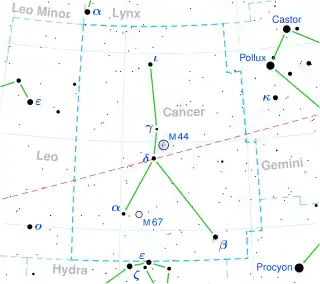Alpha Cancri
Alpha Cancri (α Cancri, abbreviated Alpha Cnc, α Cnc), also named Acubens /ˈækjuːbɛnz/,[12] is a star system in the constellation of Cancer.
 | |
| Observation data Epoch J2000.0 Equinox J2000.0 (ICRS) | |
|---|---|
| Constellation | Cancer |
| Right ascension | 08h 58m 29.2042s[1] |
| Declination | +11° 51′ 27.649″[1] |
| Apparent magnitude (V) | 4.20 to 4.27[2] |
| Characteristics | |
| Spectral type | kA7VmF0/2III/IVSr[3] |
| U−B color index | +0.15[4] |
| B−V color index | +0.14[4] |
| R−I color index | +0.04[4] |
| Astrometry | |
| Radial velocity (Rv) | −12.1±0.8[5] km/s |
| Proper motion (μ) | RA: 42.181[1] mas/yr Dec.: −31.160[1] mas/yr |
| Parallax (π) | 18.3304 ± 0.3216 mas[1] |
| Distance | 178 ± 3 ly (54.6 ± 1.0 pc) |
| Absolute magnitude (MV) | 0.46[6] |
| Details | |
| Aa + Ab | |
| Mass | 2.10[7] M☉ |
| Luminosity | 50.55[8] L☉ |
| Temperature | 7,943[9] K |
| Metallicity | 3.73[9] |
| Rotational velocity (v sin i) | 75[10] km/s |
| B | |
| Mass | 0.38[7] M☉ |
| Other designations | |
| Database references | |
| SIMBAD | data |
Nomenclature
α Cancri (Latinised to Alpha Cancri) is the star's Bayer designation.
The traditional name Acubens (Açubens) is derived from the Arabic الزبانى al zubanāh, 'the claws'.[13] A second name, Sertan /ˈsɜːrtæn/, derives from the Arabic al-saraṭān, 'the crab'. The International Astronomical Union Working Group on Star Names (WGSN) choose 'Acubens' as the proper name for this star.[14]
Properties
Alpha Cancri is a fourth-magnitude star with an apparent magnitude of 4.20, making it barely visible to the naked eye under good lighting conditions. Nevertheless, it is 23 times more luminous than the Sun. Its stellar classification is given as kA7VmF0/2III/IVSr, indicating an Am star with calcium K-lines similar to an A7 main sequence star and hydrogen lines more like an F0 giant or subgiant star. The distance of Alpha Cancri calculated from the Gaia Data Release 2 parallax is roughly 50 parsecs from Earth, or approximately 164 light-years away.
Since it is near the ecliptic, it can be occulted by the Moon and very rarely by planets.
Star system
The primary component, α Cancri A, is a white A-type main-sequence dwarf with an apparent magnitude of +4.26. Its companion, α Cancri B, is an eleventh-magnitude star. In the year 1836, its position angle was observed at 325 degrees with a separation from the main star α Cancri A of 11.3 arcseconds.[15][16]
From studying its light curve during occultation, it is thought that α Cancri A may itself be a close binary, consisting of two stars with similar brightness and a separation of 0.1 arcsecond.[4]
In modern culture
USS Acubens (AKS-5) was a United States Navy ship.
References
- Brown, A. G. A.; et al. (Gaia collaboration) (2021). "Gaia Early Data Release 3: Summary of the contents and survey properties". Astronomy & Astrophysics. 649: A1. arXiv:2012.01533. Bibcode:2021A&A...649A...1G. doi:10.1051/0004-6361/202039657. S2CID 227254300. (Erratum: doi:10.1051/0004-6361/202039657e). Gaia EDR3 record for this source at VizieR.
- NSV 4327, database entry, New Catalogue of Suspected Variable Stars, the improved version, Sternberg Astronomical Institute, Moscow, Russia. Accessed on line October 20, 2009.
- Sreedhar Rao, S.; Abhyankar, K. D. (1991). "MK morphological study of AM stars at 66 A/Mm". Journal of Astrophysics and Astronomy. 12 (2): 133. Bibcode:1991JApA...12..133S. doi:10.1007/BF02709302. S2CID 59324843.
- HR 3572, database entry, The Bright Star Catalogue, 5th Revised Ed. (Preliminary Version), D. Hoffleit and W. H. Warren, Jr., CDS ID V/50. Accessed on line October 20, 2009.
- Gontcharov, G. A. (2006). "Pulkovo Compilation of Radial Velocities for 35 495 Hipparcos stars in a common system". Astronomy Letters. 32 (11): 759–771. arXiv:1606.08053. Bibcode:2006AstL...32..759G. doi:10.1134/S1063773706110065. S2CID 119231169.
- Anderson, E.; Francis, Ch. (2012), "XHIP: An extended hipparcos compilation", Astronomy Letters, 38 (5): 331, arXiv:1108.4971, Bibcode:2012AstL...38..331A, doi:10.1134/S1063773712050015, S2CID 119257644.
- Tokovinin, A. A. (1997). "MSC - a catalogue of physical multiple stars". Astronomy and Astrophysics Supplement Series. 124: 75–84. Bibcode:1997A&AS..124...75T. doi:10.1051/aas:1997181.
- McDonald, I.; Zijlstra, A. A.; Boyer, M. L. (2012). "Fundamental parameters and infrared excesses of Hipparcos stars". Monthly Notices of the Royal Astronomical Society. 427 (1): 343. arXiv:1208.2037. Bibcode:2012MNRAS.427..343M. doi:10.1111/j.1365-2966.2012.21873.x. S2CID 118665352.
- Baines, Ellyn K.; Armstrong, J. Thomas; Schmitt, Henrique R.; Zavala, R. T.; Benson, James A.; Hutter, Donald J.; Tycner, Christopher; Van Belle, Gerard T. (2018). "Fundamental Parameters of 87 Stars from the Navy Precision Optical Interferometer". The Astronomical Journal. 155 (1): 30. arXiv:1712.08109. Bibcode:2018AJ....155...30B. doi:10.3847/1538-3881/aa9d8b. S2CID 119427037.
- Royer, F.; Grenier, S.; Baylac, M.-O.; Gómez, A. E.; Zorec, J. (2002). "Rotational velocities of A-type stars in the northern hemisphere. II. Measurement of v sin i in the northern hemisphere". Astronomy and Astrophysics (PDF). 393 (3): 897–911. arXiv:astro-ph/0205255. Bibcode:2002A&A...393..897R. doi:10.1051/0004-6361:20020943. S2CID 14070763.
- "alf Cnc". SIMBAD. Centre de données astronomiques de Strasbourg. Retrieved 2009-09-20.
- Kunitzsch, Paul; Smart, Tim (2006). A Dictionary of Modern star Names: A Short Guide to 254 Star Names and Their Derivations (2nd rev. ed.). Cambridge, Massachusetts: Sky Pub. ISBN 978-1-931559-44-7.
- Richard Hinckley Allen: Star Names — Their Lore and Meaning: Cancer
- "Naming Stars". International Astronomical Union. Retrieved 2018-11-04.
- "CCDM (Catalog of Components of Double & Multiple stars (Dommanget+ 2002)". VizieR. Centre de Données astronomiques de Strasbourg. Retrieved 2010-05-13.
- "Acubens". Alcyone Bright Star Catalogue. Retrieved 2010-05-13.
External links
- Jim Kaler's Stars, University of Illinois: Acubens